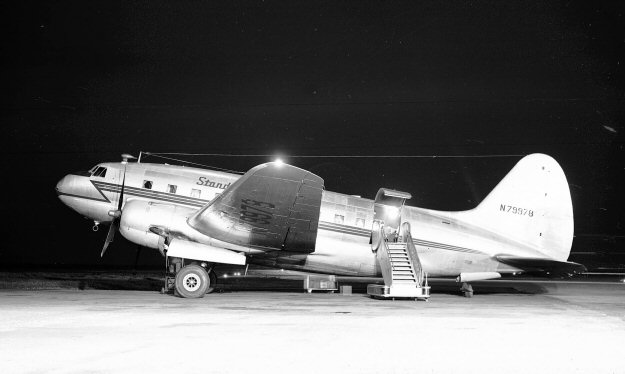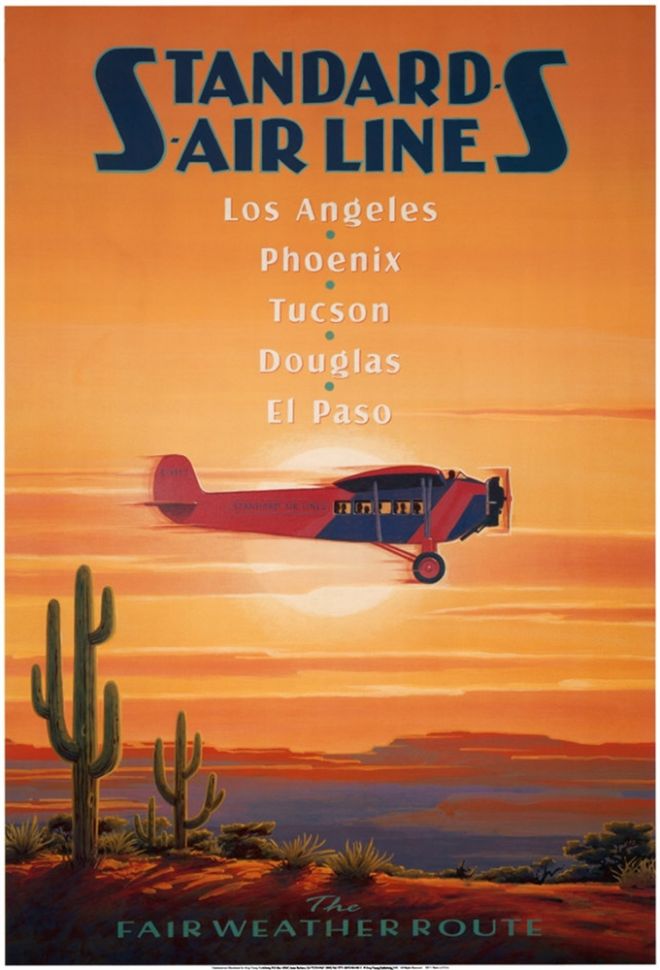Please click on each image to view in their original size. Use your browsers back (left arrow button) to return to this page.
North American Airlines – The beginning in the 1940’s
The founding four
The beginning in the 1940’s includes the four original founders who changed the way aviation standards worked.
To established U.S. airlines, North American Airlines is neither swan nor goose but an unloved and awkward swoose. Technically, a nonscheduled operator under CAB rules calls for “irregular” and “infrequent” flights. It has nevertheless grown into a $9,000,000 outfit operating one of the biggest transcontinental air-coach services.
Last week, with North American’s 1954 sales topping $11 million, the CAB decided to clip the big hybrid’s wings. A CAB examiner recommended that North American be grounded for operating a scheduled airline in violation of CAB regulations.
The trouble was nothing new for North American’s four Los Angeles co-owners—Stanley Weiss, 43, James Fischgrund, 39, Ross R. Hart, 40, and Jack B. Lewin, 42. Separately and together, they have been fighting CAB for years. Standard Airlines was then formed by Fischgrund and Weiss, both military veterans of the Second World War. Together they purchased 2 war-time surplus Douglas C-47s.
Hart and Lewin, two Douglas Aircraft employees, formed their own Viking Airlines with the money raised from 29 coworkers. The two lines pioneered cut-rate air-coach flights. By 1948 they had 80% of the transcontinental air-coach business sewed up between them.

CAB vs NAA
Representatives of the nonscheduled airlines denounced CAB as the servant of major scheduled carriers. “They have used every conceivable and questionable device to force the healthful competition of the irregular carriers out of existence”, as said by James Fischgrund.
One lawyer called the proposed action “wholesale injustice by the shotgun method.” The representatives acknowledged that a few “bad apples” existed within the non-scheduled industry, but vociferously denied that all non-skeds purposefully violated CAB structure and deserved a blanket punishment.
Most American families could not afford to travel by air with regular carrier fares. Defending their usefulness to the American public, they were inspired to a degree of competition that was previously nonexistent under the CAB’s tight economic controls. The New York Port Authority and the Department of Justice contributed their support to the non-skeds’ cause. Combined, they requested that the CAB delay its order until the value of the nonscheduled airline industry could be reassessed.
The CAB offered no such reprieve. On 14 April 1949, the CAB notified large irregular carriers they had thirty days to apply for interim licenses.
Less than thirty days later, CAB filed its first round of criminal charges against Standard Air Lines.
The CAB accused Standard of violating its “irregular” doctrine by flying more frequently than permitted. Another claim was they were offering a service indistinguishable from the scheduled airlines. On 21 July the United States Court of Appeals rejected Fischgrund’s appeal and ordered Standard to cease and desist.
Viking Air Lines was next and was eliminated in June 1950 for operating excessive flights and charging fares not prescribed by the CAB. Seaboard & Western Airlines and Transocean Air Lines, were censured and ordered to immediately discontinue practices not expressly approved in the CAB’s regulations under penalty of dissolution. By 11 June 1950, there were 96 nonscheduled airlines left in the country.
Over the early 1950s the CAB further increased its powers over large irregular carriers and continued investigating their operations. In 1952 the CAB implemented new rules for pilots at nonscheduled airlines, requiring compliance with stricter standards of training and experience. The CAB also won jurisdiction over ticketing agencies from Congress enabling the Board to take action against the likes of North American Airlines, the largest and most lucrative of the combine schemes.
The Aircoach Transport Association, expressed its approval of CAB-controlled ticketing agencies. Many of the nonscheduled airlines had developed an unhealthy dependence upon agencies. In the last few years ticket-sellers had begun exploiting their relationship by demanding higher commissions from their clients. Some cases 50% of earned revenue was being brought in by agencies.
But the ATA found little else worthy of approbation in the CAB’s actions, and on 30 March 1953 its general manager Hamlin B. Johnston issued a statement accusing the CAB of executing “a planned program to destroy the independent airline industry.” A meeting of the Senate Subcommittee on Small Business Relations with Government convened to investigate, this time under the chairmanship of Senator Edward J. Thye, and uncovered an internal CAB memorandum written by Louis Goodkind in 1948.
Goodkind, had detailed a plot to eradicate the industry by tightening regulations until all “undesirables” were vanquished.
North American Airlines, Inc. will be submitting an application for certification as a part 121 air carrier with the FAA.
If you or someone you know has an interest in contributing original photos or information please select the Contact Us page above.

